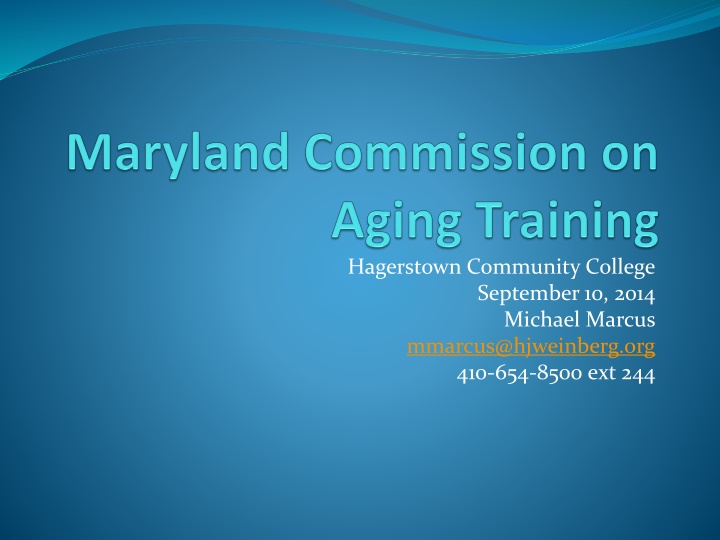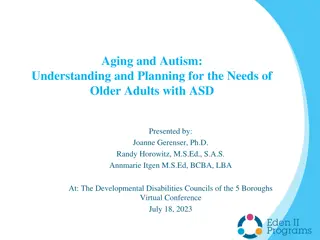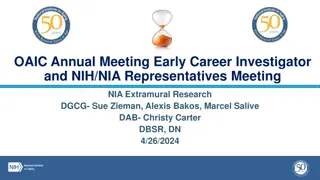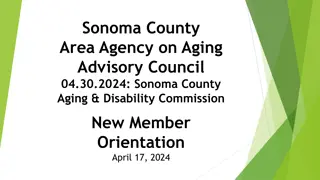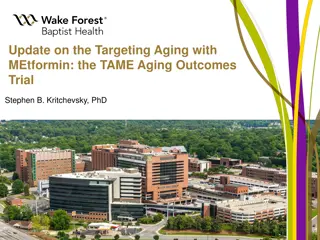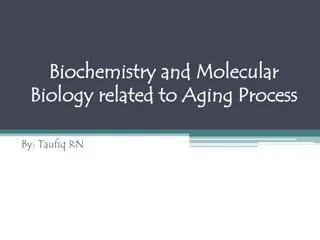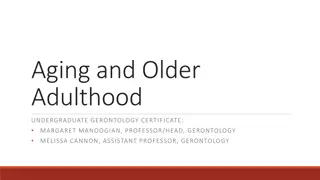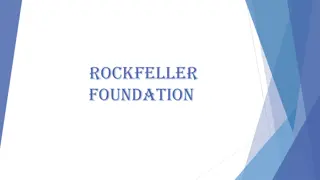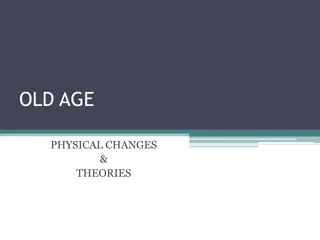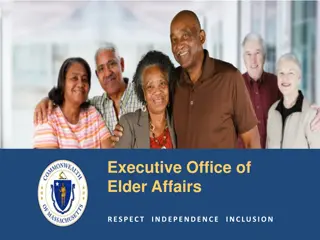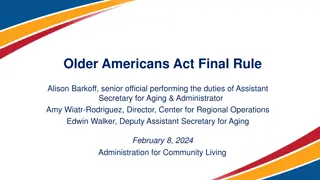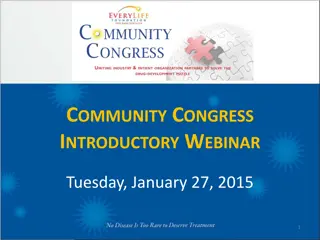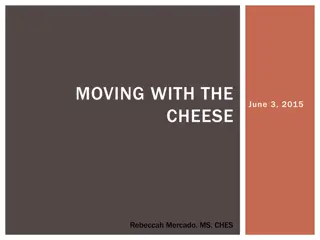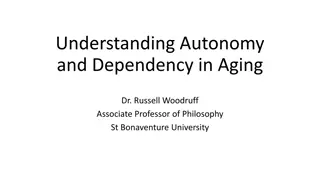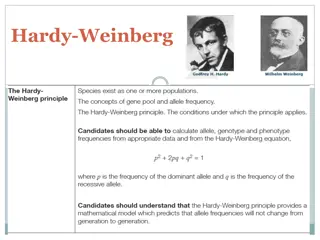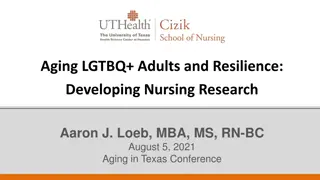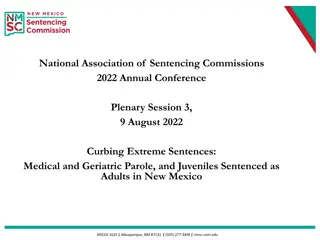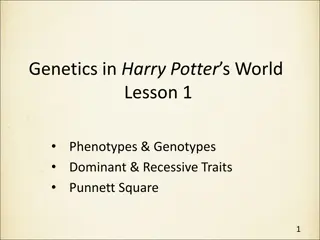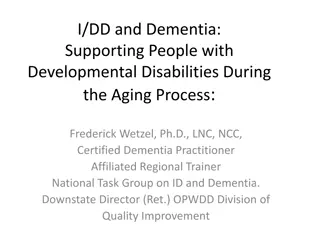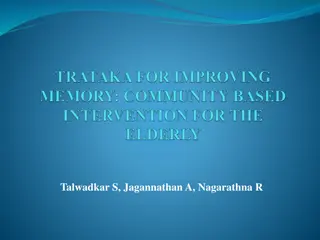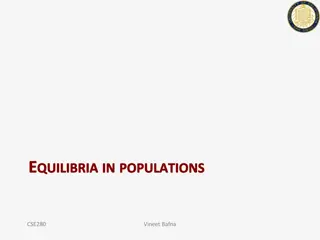Focus on Aging and Community Support Initiatives by The Harry and Jeanette Weinberg Foundation
The Harry and Jeanette Weinberg Foundation is dedicated to aiding low-income and vulnerable individuals through grants to nonprofits offering direct services. Their emphasis on caring for poor older adults is evident in the extensive support provided in various areas such as community-based services, caregiver supports, elder economic security, affordable housing, and workforce development. Aging demographics in Maryland highlight the significant impact of Social Security on reducing poverty among older residents.
Download Presentation

Please find below an Image/Link to download the presentation.
The content on the website is provided AS IS for your information and personal use only. It may not be sold, licensed, or shared on other websites without obtaining consent from the author.If you encounter any issues during the download, it is possible that the publisher has removed the file from their server.
You are allowed to download the files provided on this website for personal or commercial use, subject to the condition that they are used lawfully. All files are the property of their respective owners.
The content on the website is provided AS IS for your information and personal use only. It may not be sold, licensed, or shared on other websites without obtaining consent from the author.
E N D
Presentation Transcript
Hagerstown Community College September 10, 2014 Michael Marcus mmarcus@hjweinberg.org 410-654-8500 ext 244
A test of a people is how it behaves toward the old. Abraham Joshua Heschel
The Harry and Jeanette Weinberg Foundation Mission: To help low-income and vulnerable individuals and families by providing grants to nonprofits that provide direct services. While others are finding the cures for all the ills of the world, someone will be hungry, someone will be cold. That s our job.
Older Adults No other American foundation of similar size has emphasized care for poor older adults to the extent demonstrated by The Weinberg Foundation. The Foundation is the #1 funder in the field of Aging at $38-40 million a year. Seven foci: Community based services - Supportive Communities and Elder Abuse* Caregiver supports and services Making Maryland the Best Place to Grow Old* Workforce Development for paid caregivers to older adults Elder Economic Security Affordable Housing with Services* Culture change long-term care residences Community Based Centers formerly known as Senior Centers 1. 2. 3. 4. 5. 6. 7.
Total, both sexes, all ages Number Males 65 and older Percent Males 65 and older Number Females 65 and older Percent Females 65 and older Number 65 and older - both sexes Percent 65 and older - both sexes Census Year 12.4% 2000 14,409,625 41.2% 20,582,128 58.8% 34,991,753 281,421,906 13.0% 2010 17,291,694 43.0% 22,937,018 57.0% 40,228,712 310,232,863 16.1% 2020 24,323,182 44.4% 30,481,288 55.6% 54,804,470 341,386,665 19.3% 2030 32,293,978 44.8% 39,797,937 55.2% 72,091,915 373,503,674 20.0% 2040 36,396,362 44.8% 44,842,029 55.2% 81,238,391 405,655,295 20.2% 2050 39,916,666 45.1% 48,630,307 54.9% 88,546,973 439,010,253
In Maryland In 2010 Maryland Residents 60+ represented 17.9% of the State's Population, 16.7% of the residents of Baltimore City. By the year 2020 Maryland Baby Boomers, 55 to 74 years of age will represent 29% of the State s population Those 75+ will represent another roughly 5% of the population, and growing Nearly half of Maryland s older residents would be living in poverty if it were not for Social Security. Each year Marylanders receive over $9 Billion from Social Security alone. Older adults make a significant contribution to the State of Maryland.
Making Maryland the Best Place to Grow Old Built on the Foundation s 3 year, $8.4 m (plus $8 m matching) national Family and Informal Caregiver Initiative, 14 sites in 9 states. Every one continues to operation. Over 400,000 caregivers received services. 2400 participants in the project assessment. Services to these participants saved over $38 m in public expenditures. 4 part, 5 to 7 year initiative, beginning in Baltimore and reaching out. - Replicating 12 core services and supports for caregivers. - Developing 3 additional services: Urgent alert; wheelchair transportation; durable medical equipment lending. - Enhanced paid caregiver training, support and supervision. - No wrong door access.
Five Grants Made Thus Far Civic Works -- Cities for All Ages Benefits Data Trust Maryland Outreach Project Johns Hopkins Bayview Strengthening Caregiver Partnerships SAGE SAGECAP (Caregiver Action Program) National Council on Aging Elder Security Initiative/Economic CheckUp
Leading Issues A shortage of professional Caregivers: Currently 2.5 million, the US will need 4 million by 2020. We need more older adult caregivers than K-12 teachers. Caregiving Industry: poor pay, high turnover, little oversight, and almost no consistency in training standards. Volunteer (Informal) Caregivers: Currently, an estimated 30-70 million Americans provide support to roughly 13 million people over 65 at a value estimated at over $400 billion a year.
Leading Issues Available data from state Adult Protective Services (APS) agencies show an increasing trend in the reporting of elder abuse The most recent major studies on incidence reported that 7.6% 10% of older adults report having experienced abuse in the prior year. This does not include financial abuse. Most experts believe 60% of elder abuse is financial abuse Many believe 20% to 25% of older adults have suffered abuse. One study estimated that only 1 in 14 cases of elder abuse ever comes to the attention of authorities.The New York State Elder Abuse Prevalence Study found that for every case known to programs and agencies, 24 were unknown.
Leading Issue There is a national shortage of affordable housing between 7 - 9 million rentals. Older adults are more likely than their younger adults to spend more than 30% on their home. Almost half those earning under 50% of area median income spend over 50% of their income for housing. There are 10 older adults waiting for every unit of Section 202 housing that becomes available. There is a lack of housing with services. Senior housing was built expecting people to stay 6 years, today 12 is more typical. Today the average age is 84.
Leading Issues An increasingly complex services and benefits sector (aka intimidating forms and processes. Less than 50% of eligible seniors receive SNAP (Food Stamps); SSI requires three separate doctor s determinations to qualify; Medicare requires people to choose which plan to purchase. The elder sufficiency line is estimated at $25,000, yet nearly 40% of those 65+ live on Social Security alone Average SS income is $1,250 or $15,000 (2011); poverty for 65+ is $11,011 (2012) lower than general poverty line $11,945 (2012); over 70% make under 300% of poverty
Leading Issues The growing need for care is great: 55% of all cancers are diagnosed in individuals 65+. The number of seniors with diabetes is expected to double by 2030 (to 10.6 million). The number of older adults with Alzheimer s disease is expected to grow by 50% by 2030 to 7.7 million. Half of people with Medicare spend at least 15% of their incomes on hospital care and other health services. The average Medicare beneficiary requires more than $1,200 in prescriptions each year. For the 50% of seniors whose income falls below $22,000/year, this represents a significant outlay. As of 2010, only around 40% of seniors who qualify for the Part D Low-Income Subsidy were receiving the benefit.
So What About Villages? They are a great idea Asset based approaches are the core of successful strategies for change Two concerns - Access to ADL deficit services - Access for those who do not have the fundes
Leading Issues Is there a role for Senior Centers? Senior Centers act as the focal point for more than 60% of senior services. There are at least three types: Multi-purpose, Intergenerational, Single- program focus. Average client is female, 70-79, white, low- to middle-income, desires social interaction, lower education level. Boomers are not interested in traditional senior centers. (BoomerANG Study North Penn Community Health Foundation)
Some Responses Community Services Retooling community based programming to accommodate frailer individuals including supportive communities, villages, and no wrong door. No wrong door is a guiding Weinberg Principle, it means the older adult or her/his caregiver can walk through any door and be connected to the entire network of services they need. Rethinking transportation including peer support, new voucher programs, volunteer reimbursement and insurance programs Partners In Care, ITN 19
Some Responses New Approaches to Caregiving Caregiver Support: Caregiver support programs offering training, rethinking respite, rethinking the use of technology, collaborative efforts outside the aging network. Caregiver Support Programs: Develop focused training and recruiting other volunteers using an asset-based approach. Chronic Self-care: Peer health educators, chronic self-care, nutrition and falls prevention programs, great use of paraprofessionals.
Some Responses Workforce Development Caregiver Recruitment: Creation of caregiver recruitment efforts. Caregiver Pay: Incentives, master caregivers, new approaches to managed HCBS care. Training: State by state consistency, more hands-on, more practicum, accredited curriculums and methodology. Peer services: The average age of a professional caregiver is now around 50. There is a movement to train older people to carry out some of the lighter duties. Some states are very focused on recruiting family members to become paid caregivers.
Some Responses Housing Housing Options: Housing with services Enhanced home modification programs, Intergenerational housing, Co-housing, Scattered site housing, Renewed attention to the In-law apartment , Renegotiating 202s, new 811 program.
Possible Responses Facilities Providing Long-Term Services Culture Change the movement to transform the institutional approach into one that is person-directed. In culture change, quality of care and quality of life are inseparable and equally important. Nearly 1/3 of the 16,500 nursing homes in the US describe themselves as implementing culture change, but most is just window dressing pets and plants. Wide range of approaches some emphasizing facility design, individual autonomy, smaller numbers in groups.
Some Responses Elder Abuse Fund the Elder Justice Act, passed in 2010 as part of the ACA, the WH had proposed $25 million which includes some special initiative funding. Develop model Multi Disciplinary Teams (MDTs), an on-going collaboration between prosecutors, APS, social service providers, health providers. In some states, notably Illinois, they are required by law and funded by the state legislature. Create more Elder Abuse Shelters, providing elder abuse victims a safe place to go while they heal and services which help make them whole, legal assistance, forensic accounting, housing services, etc. Now 10 in the U.S., including 2 in Maryland, 6 more in development.
Thanks For All You Do! Michael Marcus mmarcus@hjweinberg.org 420-654-8500 ext 244
